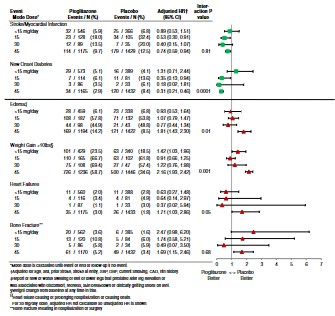UB教授がこの薬の臨床経験をもとに、さらなる研究を提唱した UB professor’s clinical experience with the drug led him to advocate for additional study
2022-03-31 バッファロー大学(UB)
・この研究は、「Efficacy of Lower Doses of Pioglitazone After Stroke or Transient Ischemic Attack in Patients With Insulin Resistance」と題され、3月6日にDiabetes, Obesity and Metabolism誌に発表された。
<関連情報>
- https://www.buffalo.edu/news/releases/2022/03/030.html
- https://dom-pubs.onlinelibrary.wiley.com/doi/10.1111/dom.14687?af=R
インスリン抵抗性を有する患者における脳卒中または一過性脳虚血発作後のpioglitazoneの低用量投与による有効性 Efficacy of lower doses of pioglitazone after stroke or transient ischaemic attack in patients with insulin resistance
J. David Spence,Catherine Walter N. Kernan ,Lawrence H. Young ,Karen Furie,Ralph DeFronzo,Muhammad Abdul-Ghani ,Paresh Dandona , DPhil,Silvio E. Inzucchi
Diabetes, Obesity and Metabolism First published: 06 March 2022
https://doi.org/10.1111/dom.14687

Abstract
Aims
Pioglitazone is a potent insulin-sensitizing drug with anti-atherosclerotic properties, but adverse effects have limited its use. We assessed the benefits and risks of lower versus higher doses of pioglitazone taken by participants in the Insulin Resistance Intervention in Stroke Trial.
Materials and Methods
Efficacy [myocardial infarction (MI) or recurrent stroke] new-onset diabetes) and adverse outcomes (oedema, weight gain, heart failure and bone fracture) were examined for subjects assigned to pioglitazone or placebo within strata defined by mode dose of study drug taken (i.e. the dose taken on most days in the study).
Results
Among the 1938 patients randomized to pioglitazone, the mode dose was <15 mg/day in 546 participants, 15 mg/day in 128, 30 mg/day in 89, and 45 mg/day in 1175. There was no significant effect on stroke/MI or new-onset diabetes with <15 mg/day. For 15 mg/30 mg/day pooled, the adjusted hazard ratios (95% CI) for stroke/MI were 0.48 (0.30, 0.76; p = .002) and 0.74 (0.69, 0.94) for 45 mg/day. For new-onset diabetes, the adjusted hazard ratios were 0.34 (0.15, 0.81; p = .001) and 0.31 (0.59, 0.94; p = .001) respectively.
For oedema, weight gain and heart failure, the risk estimates for pioglitazone were lower for subjects taking <45 mg daily. For fractures, the increased risk with pioglitazone was similar across all dose strata.
Conclusions
Lower doses of pioglitazone appear to confer much of the benefit with less adverse effects than the full dose. Further study is needed to confirm these findings so that clinicians may optimize dosing of this secondary prevention strategy in patients with stroke.


